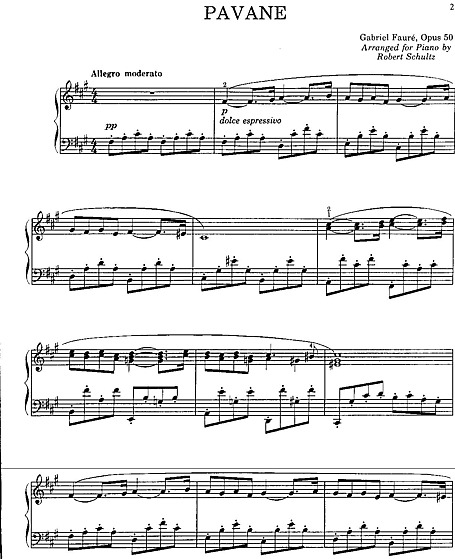Pavane
Piano Solo

- Composer
- G U Fauré
- Opus
- Op. 50
- Tonality
- F sharp minor
- Year composed
- 1887
- Pages
- 7
- Instruments
- Piano
- Difficulty
- Intermediate
- Licence
- Public domain
- Uploaded by
- Tony Wilkinson
- Filesize
- 2.35 MB
Listen

- Fauré plays Fauré Pavane, op 50
- Masters of the Roll (Reproducing Player Piano) Pavane, Op. 50 Gabriel Fauré, piano youtube.com
Reviews
About Pavane
The above text from the Wikipedia article "Pavane (Fauré)" text is available under CC BY-SA 3.0.
Other sub titles
The Pavane in F-sharp minor, op. 50, is a composition for orchestra and optional chorus by the French composer Gabriel Fauré and dates from 1887. Obtaining its rhythm from the slow processional Spanish court dance of the same name, the Pavane ebbs and flows from a series of harmonic and melodic climaxes, conjuring a cool, somewhat haunting, Belle Époque elegance. The piece is scored for only modest orchestral forces consisting of strings and one pair each of flutes, oboes, clarinets, bassoons, and horns. A typical performance lasts around seven minutes., When Fauré began work on the Pavane, he envisaged a purely orchestral work to be played at a series of light summer concerts conducted by Jules Danbe. After Fauré opted to dedicate the work to his patron, Elisabeth, comtesse Greffulhe, he felt compelled to stage a grander affair and thus he added an invisible chorus to accompany the orchestra (with additional allowance for dancers). The choral lyrics were based on some inconsequential verses, à la Verlaine, on the romantic helplessness of man, which had been contributed by the Countess' cousin, Robert de Montesquiou-Fezensac., The orchestral version was first performed at a Concert Lamoureux under the baton of Charles Lamoureux on November 25, 1888. Three days later, the choral version was premiered at a concert of the Société Nationale de Musique. In 1891, the Countess finally helped Fauré produce the version with both dancers and chorus, in a "choreographic spectacle" designed to grace one of her garden parties in the Bois de Boulogne., From the outset, the Pavane has enjoyed immense popularity, whether with or without chorus. It entered the standard repertoire of the Ballets Russes in 1917, where it was alternatively billed as Las Mininas or Les Jardins d'Aranjuez. Fauré's example was imitated by his pupils, who went on to write pavanes of their own: Ravel's Pavane pour une infante défunte and Debussy's Passepied from his Suite bergamasque.,
Other arrangements
 HQ
HQ- Full Score
- Orchestra
Free sheet music on other sites
Buy printed editions
We have selected some printed editions we think may be useful.
- Pavane - Op. 50
- $8.95
- Piano Solo
- Edition Peters
- Pavane
- $13.50
- Voice, Flute, Piano
- Edition Peters
More music by Gabriel Urbain Fauré

- Sicilienne
Piano solo - Piano
- Sicilienne
 ♪
♪- Dolly Suite
Piano Four-Hands
- Dolly Suite
 ♪
♪- Sicilienne
Cello or violin arrangement - Cello, Piano, Violin
- Sicilienne
 HQ
HQ- Sicilienne
Guitar Solo - Guitar
- Sicilienne
 ♪
♪- He is born, the divine Child
Voice, Piano, Organ
- He is born, the divine Child
Other users also liked
 ♪
♪- Pavane for a Dead Princess
Piano - Joseph-Maurice Ravel
- Pavane for a Dead Princess
 ♪
♪- Suite Española No. 1
5. Asturias (Leyenda) - Isaac Albéniz
- Piano
- Suite Española No. 1

- Romances sans paroles
No. 3 Andante moderato - Gabriel Urbain Fauré
- Piano
- Romances sans paroles
 ♪
♪- Peer Gynt Suite No. 1
4. In the Hall of the Mountain King (piano solo) - Edvard Hagerup Grieg
- Piano
- Peer Gynt Suite No. 1
 HQ
HQ- Amazing Grace
Bagpipes - Traditional
- Amazing Grace










